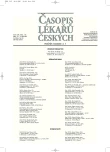-
Medical journals
- Career
Comparison of the Activities of the Elderly in Homes of Seniors in 1989 and 2000
Authors: I. Bartošovič 1; Š. Krajčík 2
Authors‘ workplace: Vysoká škola zdravotníctva a sociálnej práce sv. Alžbety, Katedra ošetrovateľstva, Bratislava 1; Slovenská zdravotnícka univerzita, Fakulta odborných špecializačných štúdií, Katedra geriatrie a gerontológie, Bratislava 2
Published in: Čas. Lék. čes. 2007; 146: 608-613
Category: Original Article
Overview
Background.
One of important factors affecting the life of the residents in seniors’ homes (SHs) is their activity in leisure time. The objective of our work was to describe these activities and their development in a period of eleven years.Methods and Results.
We have examined two sets of inhabitants of SHs with our own standardized interview: all 48 residents of one SH (average age 69.3 years) in 1989, and randomly selected 59 residents of four SHs (average age 71.2 years) in 2000. In our questionnaire, seniors answered if they took part in some of the proposed activities. The two sets of inhabitants were compared with each other, in sex and age groups, and according to cognitive impairments and mobility. In statistical evaluations we used the χ-square test in contingency tables. The inhabitants reported 179 activities, on average 3.7 activities per one resident in 1989. In 2000 they presented 187 activities, and the average (3.2 activities per one resident) decreased slightly. In both years, the most frequent activities were walking outdoors, watching TV and listening to radio. In six of the compared activities we observed a decrease in the number of residents pursuing them in 2000. When comparing the activities in sexes, we observed a greater decrease in activities in women than in men. Comparisons in age groups revealed a greater decrease of activities in “old” inhabitants (75 + years). In 2000, a considerable number of residents (without regard to age) took part in activities organized by institutions. We observed a significant increase in the number of residents with cognitive impairments and mobility deficits.Conclusions.
The authors point at the issue of leisure time activities of the elderly in seniors’ homes. In the monitored period of eleven years, a decrease of activities was observed.Key words:
homes of seniors, activities, elderly, gerontology, cognitive impairments, mobility.
Labels
Addictology Allergology and clinical immunology Angiology Audiology Clinical biochemistry Dermatology & STDs Paediatric gastroenterology Paediatric surgery Paediatric cardiology Paediatric neurology Paediatric ENT Paediatric psychiatry Paediatric rheumatology Diabetology Pharmacy Vascular surgery Pain management Dental Hygienist
Article was published inJournal of Czech Physicians

-
All articles in this issue
- Homage to McKusick’s „Mendelian Inheritance in Man“ McKusick’s database MIM has grown since its early beginning in sixties
- Milestones of Cardiovascular Therapy. IV. Reserpine
- Ten Years Since the Successful Introduction of the First Monoclonal Antibody (Rituximab) into the Therapy of Lymphomas
- Proteomics Techniques and their Application in Haematological Malignancies
- Use of Capillary Electrophoresis in the Clinical Research
- Thrombembolic Complications of Sepsis and Their Pharmacological Prophylaxis
- The Information Value of Detection of Borrelia Antibodies in the Healthy Blood Donors and in the Population at Risk
- Comparison of the Activities of the Elderly in Homes of Seniors in 1989 and 2000
- Clostridial Sepsis and Gas Gangrene of the Abdominal Wall After Cholecystectomy
- Journal of Czech Physicians
- Journal archive
- Current issue
- Online only
- About the journal
Most read in this issue- Milestones of Cardiovascular Therapy. IV. Reserpine
- Clostridial Sepsis and Gas Gangrene of the Abdominal Wall After Cholecystectomy
- Use of Capillary Electrophoresis in the Clinical Research
- Ten Years Since the Successful Introduction of the First Monoclonal Antibody (Rituximab) into the Therapy of Lymphomas
Login#ADS_BOTTOM_SCRIPTS#Forgotten passwordEnter the email address that you registered with. We will send you instructions on how to set a new password.
- Career

